Koalas, up close and personal
By learning more about koalas, people may help save the animals from an uncertain future.
By Emily Sohn
Koalas are, hands down, the cutest animals I’ve ever seen in the wild. With fluffy fur, pudgy bodies, round eyes, and wisps of spiky hair sprouting from behind their ears, koalas look like teddy bears with attitude.
Every time I saw a koala during my recent trip to Australia, I pulled out my camera and started clicking. And I’m not alone in my fascination for these cuddly-looking creatures.
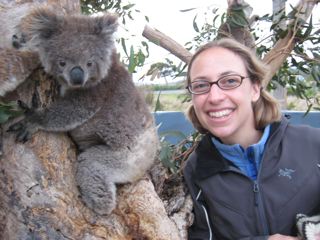 |
|
The author, Emily Sohn, befriends a female koala named Bea in Australia.
|
| Hannah Hoag |
“People get caught up in the emotions [stirred by] koalas,” says koala ecologist Alistair Melzer of Central Queensland University in northeastern Australia. “Everyone feels the same way about them. They’re so cute.”
For years, such emotions got in the way of science, Melzer says. One result is that people still make assumptions about koalas that are not true.
“People tend to think of the koala as a cute and uninteresting animal that sits around, chews leaves, spends most of its time asleep, and generally doesn’t do very much,” Melzer says. But “when you start to study the koala, you realize it is quite a complex animal.”
Only recently have researchers begun to piece together details of how koalas actually live. And as koala habitat disappears because of global warming, this research may protect the animals from an uncertain future.
All about koalas
Like kangaroos, koalas belong to a group of mammals called marsupials. Female marsupials have pouches in which they carry their babies.
When a koala is born, it’s about the size of a jellybean. It is blind, deaf, and hairless, yet it still manages to crawl into its mother’s pouch. There, it drinks milk and grows for about 7 months before emerging for the first time.
A young koala starts eating leaves soon after leaving the pouch, but it also continues to drink its mother’s milk until it’s about a year old. When a koala gets too big to fit into the pouch, its mother carries it on her back. This handy form of transportation continues until the youngster is fully grown.
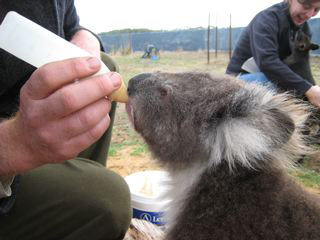 |
|
Being mammals, young koalas drink milk that comes from their mothers—or from a bottle provided by a willing researcher.
|
| Emily Sohn |
Koalas live throughout Australia in a variety of environments, from hot and dry to cool and wet. They eat the leaves of eucalyptus trees. In fact, eucalyptus leaves are the only thing adult koalas eat. As long as they have access to certain species of these trees, koalas will thrive. Without them, koalas will die.
A history of koalas and people
Koalas have faced some hardships over the years. Since Europeans settled in Australia in the 1700s, 80 percent of the eucalyptus trees on which the koalas depend have been cut down to make way for human developments. And until about 80 years ago, people hunted the animals for their fur.
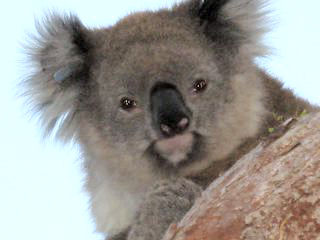 |
|
Scientists aim to protect koalas, which have lost habitat.
|
|
Emily Sohn
|
By the early 1900s, koalas had become extinct or nearly extinct in many areas of Australia. However, by using a small number of the remaining animals as breeding stock, scientists were able to bring koala populations back up. Today, the animals are thriving in many places.
But the koalas still have some problems. Because populations dwindled a century or so ago, all the koalas in southern Australia today are descended from a small number of recent ancestors. As a result, today’s populations share many genes. On some islands off the mainland, breeding between close relatives has led to deformities and disease. Scientists fear is that the same trend could happen on the mainland.
Dry spell
In other parts of Australia, koalas are in trouble because of climate change. In the past 10 years, drought has gripped the continent. Koalas get 90 percent of the water they need from the leaves they eat. Without rain, trees lose their leaves, and koalas develop dehydration, which can lead to heat stroke. If untreated, heat stroke can kill.
In the early days of the drought, people in Queensland started to notice koalas stumbling around and dying during the middle of the day, Melzer says. Normally, koalas are good at handling temperature swings. Like cats, they curl up when it’s cold and sprawl out when it’s hot. But as their trees disappear, they have a harder time regulating their body temperatures because they have fewer places in which to seek shade and shelter.
Throughout Australia, dry, hot weather has also led to a growing number of wildfires. In January, a fierce blaze swept through a community called Framlingham in the south, destroying 95 percent of the region’s koala habitat, says wildlife rehabilitator Shayne Neal.
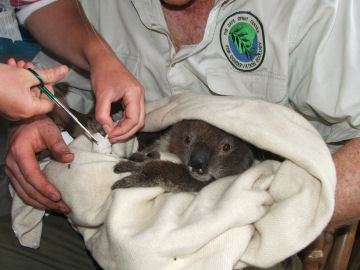 |
|
In January 2007, a fire destroyed koala habitat and killed or injured many of the animals. Wildlife rehabilitators treated injured koalas (above) and looked after them during their recovery (below).
|
|
Lizzie Corke and Shayne Neal
|
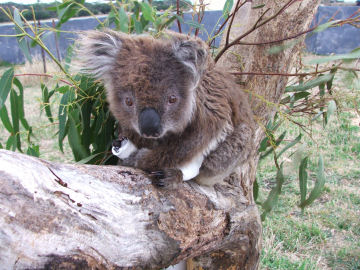 |
With his wife, Lizzie Corke, Neal runs the Cape Otway Centre for Conservation Ecology, where the couple takes in wounded animals and nurses them back to health. (See “News Detective: Emily Nurses Wild Animals”) Thousands of animals, including koalas and kangaroos, died in the fires, and hundreds more were orphaned and injured.
“In sheer numbers, there’s never been a fire like the Framlingham fire,” Corke says. “It was a small area, but [it had] a big wildlife impact.”
Trying to learn more
Researchers want to learn as much as they can about koalas so that they can help the animals survive a changing climate. It’s not always easy, since koalas tend to hide, making them hard to count and track.
Melzer and colleagues have been tagging koalas and tracking them with radio collars. Sometimes they watch individual koalas on St. Bees Island off the coast of Queensland for 24 hours at a time. The researchers also collect koala droppings to see what the young animals are eating.
Melzer’s results show that koalas do about 80 percent of their eating at night, which scientists already knew. But what’s surprising, he says, is that the animals move to different trees during the day. At night, they seek food and shelter in eucalyptus trees. During the day, they move elsewhere. And for reasons that still aren’t clear, different koalas choose different types of trees—and not necessarily eucalyptus trees—to spend their days.
In other words, koalas follow a complex pattern of movement from day to night, Melzer says. What’s more, even though there are hundreds of species of eucalyptus trees in Australia, koalas usually only eat a few of those species. This type of knowledge should help conservationists figure out how best to protect the animals.
“Koalas are the easiest animals in the world to conserve,” Melzer says. “All they need is the right trees and the right places, and they can live happily. In theory, it’s very, very simple.”
Real life, however, is complicated, even for an animal as cute as the koala.
Koala Facts:
Koalas have specially adapted intestines that can digest eucalyptus leaves, which are toxic to most animals.
Koalas in different parts of Australia have different kinds of fur and are different sizes, but they still belong to the same species.
That species, Phascolarctos cinereus, is the only living member of the animal family Phascolarctidae.
Going Deeper:







